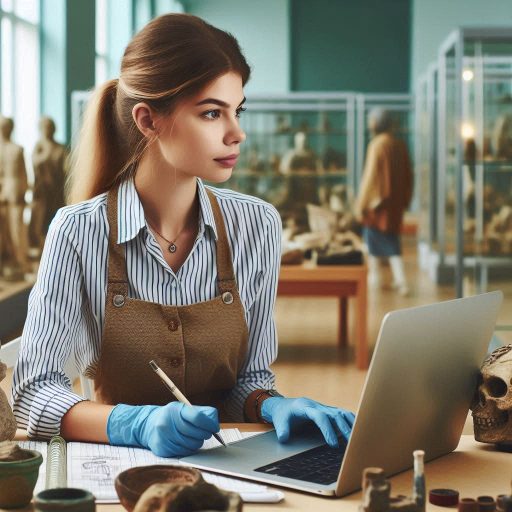Introduction
Archaeology is the scientific study of past human life and civilizations through the excavation and analysis of material remains, including artifacts, structures, and landscapes.
It plays a crucial role in understanding our collective history, shedding light on the lives, cultures, and technologies of ancient societies.
By studying these physical remnants, archaeologists help piece together stories of the past, offering valuable insights into how humans have evolved socially, culturally, and technologically.
The importance of archaeology lies in its ability to reveal hidden aspects of human history that written records often overlook or fail to capture.
Through careful excavation and analysis, archaeologists can uncover details about everyday life, economic systems, religious practices, and social hierarchies that might otherwise remain unknown.
By studying the past through archaeological methods, we gain a deeper appreciation of human resilience, innovation, and adaptation over millennia.
Archaeology has evolved significantly since its early days, when it was primarily focused on treasure hunting or the collection of antiquities.
Today, it is a multidisciplinary field that incorporates advanced technologies such as radiocarbon dating, ground-penetrating radar, and 3D scanning.
These innovations have revolutionized how archaeologists conduct their research, enabling more precise dating, accurate mapping of sites, and non-invasive exploration of buried structures.
As the field continues to evolve, archaeology remains at the forefront of exploring humanity’s rich and diverse history, bridging the gap between ancient civilizations and modern-day knowledge.
Technology in Archaeology
Use of Advanced Technologies such as LiDAR, Satellite Imaging, and Ground-Penetrating Radar
Advanced technologies like LiDAR, satellite imaging, and ground-penetrating radar (GPR) are transforming archaeology.
LiDAR (Light Detection and Ranging) uses laser pulses to map landscapes, revealing hidden structures beneath dense forests.
Satellite imaging captures broad, high-resolution views of archaeological sites, helping researchers identify patterns and previously unknown features.
GPR allows archaeologists to detect buried structures by sending electromagnetic signals into the ground, bouncing back detailed data without disturbing the earth.
These technologies have become essential tools in modern archaeology, replacing traditional methods with more precise, non-invasive techniques.
How Technology is Revolutionizing the Field by Making Discoveries More Accurate and Efficient
Technology is revolutionizing archaeology by improving both the accuracy and efficiency of discoveries.
Traditional excavation methods are slow and labor-intensive, but advanced technologies expedite the process.
With LiDAR, archaeologists can map entire sites in a fraction of the time it once took, allowing for quicker analysis and planning.
Satellite imaging helps researchers locate potential excavation spots with pinpoint accuracy, minimizing unnecessary digging.
Ground-penetrating radar identifies specific buried objects or structures, reducing the chance of damaging important artifacts.
These innovations make archaeological research faster, more focused, and more environmentally friendly, preserving sites while still yielding valuable information.
Examples of Recent Archaeological Breakthroughs Due to Technological Advancements
Recent breakthroughs demonstrate how technology is reshaping archaeology.
In 2018, LiDAR uncovered over 60,000 hidden Mayan structures beneath the Guatemalan rainforest.
This discovery, which included pyramids, homes, and road networks, provided new insights into the complexity of Mayan civilization.
In Egypt, ground-penetrating radar revealed unknown chambers behind King Tutankhamun’s tomb walls, sparking speculation about hidden treasures.
Another example is the use of satellite imaging to discover hundreds of ancient settlements in the Amazon basin.
These discoveries, made possible through technological advancements, are reshaping our understanding of past civilizations and opening new frontiers in archaeological research.
Read: Interdisciplinary Research: Botany and Other Sciences
Interdisciplinary Approaches
Collaboration with Other Fields such as Geology, Biology, Chemistry
Archaeology is increasingly collaborating with fields like geology, biology, and chemistry to enhance discoveries.
Geologists assist archaeologists in understanding the environmental and geological conditions of ancient sites.
They help explain how landscapes have changed over time, offering clues to how ancient civilizations adapted.
Biologists contribute through bioarchaeology, studying human and animal remains to provide insights into ancient diets, health, and migration patterns.
Chemists analyze artifacts and soil samples, using techniques like radiocarbon dating to determine the age of objects.
These interdisciplinary collaborations bring new expertise, expanding the scope of what archaeology can achieve.
Importance of Interdisciplinary Approaches in Gaining a Holistic Understanding of the Past
Interdisciplinary approaches offer a more comprehensive understanding of ancient cultures.
Archaeology alone can reveal physical structures and artifacts, but collaboration with other sciences provides a deeper context.
By working with geologists, archaeologists learn how environmental factors influenced human settlement patterns.
Biologists provide insights into the health and nutrition of ancient populations, while chemists help pinpoint the age of artifacts and reconstruct ancient technologies.
This combined expertise allows for a fuller picture of how ancient civilizations lived, adapted, and evolved over time.
A holistic view emerges, enriching our knowledge beyond what archaeology alone can provide.
How These Collaborations are Shaping the Future of Archaeology
The future of archaeology is being shaped by increasing collaboration with other scientific fields.
These partnerships enable archaeologists to access cutting-edge techniques that improve the accuracy of their discoveries.
For instance, advances in DNA analysis, provided by biologists, are revealing detailed information about ancient populations, their migration patterns, and relationships.
In combination with geological studies, archaeologists are uncovering how environmental shifts influenced human history.
Chemistry continues to refine dating methods, allowing for more precise timelines of historical events.
These interdisciplinary efforts are advancing archaeology, making it a more dynamic and innovative field that continuously reshapes our understanding of the past.
Read: Women in Botany: Celebrating Pioneers and Leaders
Public Engagement and Community Involvement
The Rise of Community-Based Participatory Research in Archaeology
Community-based participatory research is becoming a prominent approach in archaeology.
This method involves collaboration between archaeologists and local communities, ensuring that the people most connected to the land play a vital role in research.
Instead of being passive observers, community members actively participate in the planning, excavation, and interpretation of archaeological projects.
By incorporating local knowledge and perspectives, this approach enriches the understanding of historical sites.
It also fosters stronger connections between the research team and the community, enhancing the overall quality and authenticity of archaeological findings.
Importance of Involving Local Communities in Archaeological Projects
Involving local communities in archaeological projects is essential for several reasons.
First, it promotes cultural sensitivity by ensuring that local traditions and histories are respected and preserved.
Communities often possess invaluable knowledge about their own heritage that can significantly enhance archaeological interpretations.
Second, involving communities helps preserve local sites by fostering a sense of ownership and stewardship among residents.
When people feel connected to their heritage, they are more likely to protect and maintain it for future generations.
This collaboration also fosters mutual learning, as archaeologists gain local insights while sharing their own knowledge and expertise with the community.
How Public Engagement is Changing the Way Archaeology is Conducted and Perceived
Public engagement is transforming both the practice and perception of archaeology.
By involving the public, archaeologists are shifting away from the traditional, exclusive model of research toward a more inclusive and collaborative one.
Community involvement brings fresh perspectives, challenges assumptions, and broadens the scope of archaeological research.
It also increases transparency, as communities can directly observe and influence how excavations are carried out.
This engagement is also changing the way archaeology is perceived by the public.
Instead of being seen as a distant academic discipline, archaeology is becoming more accessible, relevant, and connected to modern issues.
Public involvement fosters greater appreciation and respect for cultural heritage, making archaeology a more dynamic and socially responsible field.
Read: How Climate Change Is Impacting Plant Research
Environmental Archaeology
Growing Focus on the Impact of Humans on the Environment Throughout History
Environmental archaeology is increasingly focused on understanding how human activities have impacted the environment throughout history.
By studying ancient civilizations, archaeologists can uncover the long-term effects of human actions such as agriculture, urbanization, and resource extraction.
These insights reveal patterns of environmental degradation, adaptation, and resilience.
Understanding how ancient societies managed or mismanaged their environments can offer valuable lessons for addressing today’s environmental challenges.
This growing focus sheds light on the intricate relationship between humans and their surroundings, highlighting the lasting impact of past actions on the natural world.
Use of Archaeological Methods to Study Climate Change, Deforestation, and Other Environmental Issues
Archaeologists use a variety of methods to study historical environmental changes, such as climate shifts and deforestation.
By analyzing soil layers, pollen, and tree rings, environmental archaeologists can reconstruct ancient ecosystems and track changes over time.
These methods help identify periods of drought, flood, or resource depletion, offering insights into how societies adapted to environmental stresses.
For instance, the collapse of ancient civilizations like the Maya is often linked to environmental degradation, such as deforestation and soil erosion.
Archaeological evidence provides crucial data on how human activities contributed to environmental changes, including how past climate events influenced human history.
How Environmental Archaeology is Contributing to the Discussion on Sustainability and Conservation
Environmental archaeology is playing a significant role in modern discussions on sustainability and conservation.
By examining how past societies interacted with their environments, archaeologists can provide historical context for current issues like climate change, deforestation, and resource management.
These insights help guide sustainable practices today by learning from both the successes and failures of ancient civilizations.
For example, understanding how ancient farmers managed water resources or practiced crop rotation can inform modern agricultural practices.
Additionally, the study of past environmental collapses can serve as a cautionary tale, highlighting the need for sustainable resource use and conservation efforts in the present.
Environmental archaeology offers valuable lessons on how to create a balance between human needs and the preservation of natural ecosystems.
Read: Exploring the Different Branches of Geology

Digital Archaeology
Utilization of Digital Tools and Techniques in Archaeological Research and Analysis
Digital archaeology is revolutionizing the field by introducing advanced tools and techniques for research and analysis.
Technologies like 3D scanning, photogrammetry, and Geographic Information Systems (GIS) are now essential in archaeological work.
3D scanning creates highly detailed digital models of artifacts and sites, allowing for more precise analysis and virtual reconstruction.
Photogrammetry uses photographs to generate 3D images, enabling archaeologists to capture the layout of large sites with accuracy.
GIS maps spatial data, helping researchers analyze geographic patterns and relationships in historical sites.
These digital tools improve efficiency, accuracy, and collaboration in archaeological projects.
Importance of Digitizing Archaeological Data for Future Generations
Digitizing archaeological data is critical for preserving it for future generations.
By converting physical records into digital formats, researchers ensure that important data, images, and findings are stored safely and accessibly.
This process allows for easier sharing of information across global networks, facilitating collaboration among archaeologists, researchers, and scholars.
Digital archives also protect against data loss due to physical damage, deterioration, or disaster.
As future generations of archaeologists rely increasingly on digital platforms, maintaining accessible, well-preserved digital data will be essential to advancing the field and preserving the historical record.
How Digital Archaeology is Changing the Way We Preserve and Study the Past
Digital archaeology is transforming how we preserve and study the past.
With digital reconstructions, researchers can virtually recreate ancient sites, allowing for immersive study without damaging the original structures.
Virtual reality (VR) and augmented reality (AR) tools enable people to explore ancient cities, tombs, and artifacts from anywhere in the world.
These technologies democratize access to history, allowing broader audiences to engage with archaeological discoveries.
Additionally, digital preservation ensures that artifacts and sites are meticulously documented in their original condition, even if they are later altered or destroyed.
Digital archaeology is not only preserving history but also making it more accessible and engaging for future study.
Transform Your Career Today
Unlock a personalized career strategy that drives real results. Get tailored advice and a roadmap designed just for you.
Start NowEthics and Indigenous Perspectives
Increasing Awareness of the Ethical Considerations in Archaeology
There is a growing awareness of the ethical considerations in archaeology, particularly regarding repatriation of artifacts and collaboration with Indigenous communities.
Archaeologists increasingly recognize that many artifacts were removed from their cultural context without proper consent or respect for the communities they represent.
This awareness has led to calls for the repatriation of cultural heritage items to their rightful owners.
Many institutions now actively engage in discussions about returning artifacts to Indigenous communities.
This shift in perspective acknowledges the need for ethical practices that prioritize respect, consent, and the voices of those most connected to their heritage.
Importance of Incorporating Indigenous Perspectives in Archaeological Research
Incorporating Indigenous perspectives in archaeological research is crucial for a more comprehensive understanding of the past.
Indigenous communities possess valuable knowledge about their histories, cultural practices, and the significance of archaeological sites.
Collaborating with these communities fosters a more respectful and inclusive approach to research.
By integrating Indigenous perspectives, archaeologists can gain insights that traditional methods may overlook, leading to richer and more accurate interpretations of the archaeological record.
This collaboration also empowers Indigenous voices, ensuring they have a say in how their heritage is studied and presented.
How the Field is Evolving to Address Past Injustices and Inequalities
The field of archaeology is evolving to address past injustices and inequalities faced by Indigenous peoples.
Archaeologists are increasingly advocating for ethical research practices that promote collaboration and mutual respect.
Many are adopting participatory approaches, involving Indigenous communities in every stage of research, from planning to interpretation.
This shift challenges the colonial narratives that have historically dominated archaeology and encourages a more equitable relationship between archaeologists and Indigenous peoples.
As a result, the field is becoming more inclusive, recognizing the rights and perspectives of Indigenous communities.
This evolution not only helps to rectify historical wrongs but also enriches archaeological research, making it more relevant and responsible in today’s context.
Globalization of Archaeology
The Shift Towards More Global Perspectives in Archaeological Research
There is a significant shift towards more global perspectives in archaeological research.
Traditionally, archaeology often focused on localized studies, which sometimes led to narrow interpretations of human history.
However, contemporary archaeology increasingly recognizes the interconnectedness of cultures and regions.
Researchers now examine global networks, trade routes, and migration patterns that influenced the development of civilizations.
This shift allows archaeologists to understand how different cultures interacted and shared knowledge, technology, and practices.
By adopting a global perspective, the field can better capture the complexities of human history and cultural evolution.
Importance of Studying Connections and Interactions Between Different Cultures and Regions
Studying connections and interactions between different cultures and regions is crucial for a comprehensive understanding of the past.
Archaeological findings reveal how ancient societies influenced one another through trade, conquest, and cultural exchange.
For example, the spread of agricultural practices and technologies often resulted from interactions between neighboring communities.
By exploring these connections, archaeologists can uncover how ideas, customs, and innovations traveled across regions, shaping societies over time.
This approach highlights the fluidity of cultures and challenges the notion of isolated, independent societies, providing a richer narrative of human history.
How Globalization is Shaping the Future Direction of Archaeology
Globalization is significantly shaping the future direction of archaeology.
As the world becomes more interconnected, archaeological research increasingly reflects this complexity.
Researchers are now more likely to collaborate across borders, sharing findings and methodologies to enhance understanding of global patterns.
This collaboration also fosters the exchange of ideas between different cultural contexts, enriching archaeological interpretations.
Additionally, globalization encourages the preservation of cultural heritage in a rapidly changing world.
Archaeologists are working with local communities to safeguard their histories, ensuring that their voices are included in the narrative.
As a result, archaeology is evolving into a more collaborative and inclusive discipline, better equipped to address the challenges of the 21st century.
Conclusion
As we reflect on the key trends and innovations in archaeology discussed in this post, it is evident that the field is undergoing significant transformations.
The use of technology such as LiDAR, drones, and 3D modeling has revolutionized how archaeologists uncover and analyze ancient sites.
Furthermore, the focus on community engagement and indigenous perspectives highlights the importance of diverse voices in shaping our understanding of the past.
Looking forward, the future of archaeology appears to be a dynamic and evolving one.
It will continue to adapt to new technologies, methodologies, and theoretical frameworks, pushing the boundaries of what we know about our shared human history.
To remain relevant and effective in this ever-changing landscape, archaeologists must prioritize staying current, open-minded, and collaborative in their approaches.
Ultimately, the importance of staying agile and adaptive in the world of archaeology cannot be overstated.
By embracing innovation, diversity, and interdisciplinary collaboration, archaeologists can uncover new insights, challenge existing assumptions, and contribute meaningfully to our understanding of the past.
The future of archaeology is bright, filled with endless possibilities for exploration, discovery, and connection across time and space.
[E-Books for Sale]
The Big Book of 500 High-Paying Jobs in America: Unlock Your Earning Potential
$19.99 • 500 High-Paying Jobs • 330 pages
Explore 500 high-paying jobs in America and learn how to boost your career, earn more, and achieve success!
See All 500 High-Paying Jobs of this E-Book
1001 Professions Without a Degree: High-Paying American Jobs You Can Start Now
$19.99 • 1001 Professions Without a Degree • 174 pages
Discover 1001 high-paying jobs without a degree! Unlock career tips, skills, and success strategies for just $19.99!




